I found this video on Fr. Ray Blake's website, a video I had sought for years and thought quite lost. The video is two separate features, one focused on the traditionalist movement in the wake of Msgr. Lefebvre's episcopal consecrations and the other a series of vignettes of Norman life called Fr. Quintin's Normandy.
This clip gives us some insight as to what life was like in good parishes "back in the day." Fr. Montgomery-Wright sought eccentricity at every step, but aside from wearing an unnecessary monocle he had a remarkable genteel pastoral demeanor, a kindred spirit for the farming community.
The Masses he celebrated were more elaborate and less ceremonial than today's traddy Masses: coped cantors, servers in tunics, a full choir, and the priest yelling the Gloria, laus, et honor tibi sit when no one else will. His movements are both reverent and not contrived. There is a holy informality which compliments country life and which I miss greatly in Dallas.
Montgomery-Wright cared for a disabled person named Christian and extended his caring outlook to the rest of his 1,000 faithful scattered across three parishes and the Mass center in another town he ran. Even at 75 he gave no thought to leaving what he was ordained to do.
The same person who posted the clips of Fr. Montgomery-Wright also has another video entitled "SSPX UK History", which is three hours long and only worth occasionally skipping through. It is presented by Fr. Edward Black, then district superior of the Fraternity. Around the 17 minute mark there are pictures of the real Roman Holy Week at St. Joseph's in London. A few minutes later comes footage taken by a local news crew of Palm Sunday, which shows the knocking at the door and the haunting Gospel tone as Fr. Black tells the interviewer about the dilution of rites. Later on bishop Richard Williamson is shown celebrating a pontifical Mass from the faldstool in a garden; evidently the Fraternity bishops had not yet abusively assumed the practice of celebrating Mass from the throne, which was a prerogative Lefebvre was granted by Pius XII as an apostolic delegate. Most Masses for pilgrimages and special events were sung and Tenebrae was observed during Holy Week. The crowd noticeably evolves from an older group dressed quite casually (women in trousers sometimes, not all the ladies veiled, not all the men in ties) to a younger, more formal set of congregants.
Seeing these two pieces makes one wish the old rite communities nowadays had the same pastoral zeal and familiarity that those groups had in their early days, as well as their desire to maximize their liturgical functions. Have we lost something of the way we were?


.jpg)
